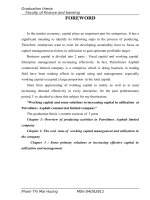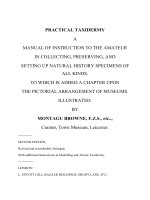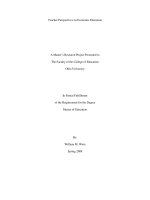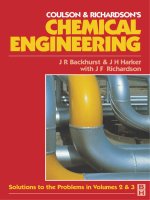Volume 5 coulson and richardson s chemical engineering (solutions to the problems in volume 2 and 3)
Bạn đang xem bản rút gọn của tài liệu. Xem và tải ngay bản đầy đủ của tài liệu tại đây (12.91 MB, 345 trang )
Coulson & Richardson’s
CHEMICAL ENGINEERING
J. M. COULSON and J. F. RICHARDSON
Solutions to the Problems in Chemical Engineering
Volume 2 (5th edition) and Volume 3 (3rd edition)
BY
J. R. BACKHURST and J. H. HARKER
University of Newcastle upon Tyne
With
J. F. RICHARDSON
University of Wales Swansea
J
E I N E M A N N
OXFORD AMSTERDAM BOSTON LONDON NEW YORK PARIS
SAN DlEGO SAN FRANCISCO SINGAPORE SYDNEY TOKYO
Butterworth-Heinemann
An imprint of Elsevier Science
Linacre House, Jordan Hill. Oxford OX2 8DP
225 Wildwood Avenue, Woburn, MA 01801-2041
First published 2002
Transferred to digital printing 2004
Copyright Q 2002, J.F. Richardson and J.H. Harker. All rights reserved
The right of J.F. Richardson and I.H. Harker to be identified as the authors of this work
has been asserted in accordance with the Copyright, Designs
and Patents Act 1988
No part of this publication may be
reproduced in any material form (including
photocopying or storing in any medium by electronic
means and whether or not transiently or incidentally
to some other use of this publication) without the
written permission of the copyright holder except
in accordance with the provisions of the Copyright,
Designs and Patents Act 1988 or under the terms of a
licence issued by the Copyright Licensing Agency Ltd,
90 Tottenham Court Road, London, England W1T 4LP.
Applications for the copyright holder’s written permission
to reproduce any part of this publication should be
addressed to the publishers
British Library Cataloguing in Publication Data
A catalogue record for this book is available from the British Library
Library of Congress Cataloguingin Publication Data
A catalogue record for this book is available from the Library of Congress
ISBN 0 7506 5639 5
Ininformationon;
Burnorth-Heinemann publications visit our website at www.bh.com
I
Preface
Each of the volumes of the Chemical Engineering Series includes numerical examples to
illustrate the application of the theory presented in the text. In addition, at the end of each
volume, there is a selection of problems which the reader is invited to solve in order to
consolidate his (or her) understanding of the principles and to gain a better appreciation
of the order of magnitude of the quantities involved.
Many readers who do not have ready access to assistance have expressed the desire for
solutions manuals to be available. This book, which is a successor to the old Volume 5, is
an attempt to satisfy this demand as far as the problems in Volumes 2 and 3 are concerned.
It should be appreciated that most engineering problems do not have unique solutions,
and they can also often be solved using a variety of different approaches. If therefore the
reader arrives at a different answer from that in the book, it does not necessarily mean
that it is wrong.
This edition of the Solutions Manual which relates to the fifth edition of Volume 2 and
to the third edition of Volume 3 incorporates many new problems. There may therefore
be some mismatch with earlier editions and, as the volumes are being continually revised,
they can easily get out-of-step with each other.
None of the authors claims to be infallible, and it is inevitable that errors will occur
from time to time. These will become apparent to readers who use the book. We have
been very grateful in the past to those who have pointed out mistakes which have then
been corrected in later editions. It is hoped that the present generation of readers will
prove to be equally helpful!
J. F. R.
vii
Contents
vii
ix
xi
Preface
Preface to the Second Edition of Volume 5
Preface to the First Edition of Volume 5
Factors for Conversion of SI units
Xiii
Solutions to Problems in Volume 2
2-1
Particulate solids
Particle size reduction and enlargement
2-2
Motion of particles in a fluid
2-3
Flow of fluids through granular beds and packed columns
2-4
2-5
Sedimentation
2-6
Fluidisation
2-7
Liquid filtration
2-8
Membrane separation processes
2-9
Centrifugal separations
2-10 Leaching
2-1 1 Distillation
2- 12 Absorption of gases
2-13
Liquid-liquid extraction
2- 14 Evaporation
2- 15 Crystallisation
2-16
Drying
2- 17 Adsorption
2-18
Ion exchange
2- 19 Chromatographic separations
Solutions to Problems in Volume 3
3-1
Reactor.design-general principles
Flow characteristics of reactors- flow modelling
3-2
3-3
Gas-solid reactions and reactors
3-4
Gas-liquid and gas-liquid-solid reactors
V
1
8
14
34
39
44
59
76
79
83
98
150
171
181
216
222
23 1
234
235
237
262
265
27 1
3-5
3-7
285
294
Biochemical reaction engineering
Process control
(Note: The equations quoted in Sections 2.1-2.19 appear in Volume 2 and those in
Sections 3.1-3.7 appear in Volume 3. As far as possible, the nomenclature used in this
volume is the same as that used in Volumes 2 and 3 to which reference may be made.)
vi
SECTION 2-1
Particulate Solids
PROBLEM 1.1
The size analysis of a powdered material on a mass basis is represented by a straight line
from 0 per cent at 1 h m particle size to 100 per cent by mass at 101 pm particle size.
Calculate the surface mean diameter of the particles constituting the system.
Solution
See Volume 2, Example 1.1.
PROBLEM 1.2
The equations giving the number distribution curve for a powdered material are dn/dd = d
for the size range 0-10 pm, and dn/dd = lo0,000/d4 for the size range 10-100 pm
where d is in pm. Sketch the number, surface and mass distribution curves and calculate
the surface mean diameter for the powder. Explain briefly how the data for the construction
of these curves may be obtained experimentally.
Solution
See Volume 2, Example 1.2.
PROBLEM 1.3
The fineness characteristic of a powder on a cumulative basis is represented by a straight
tine from the origin to 100 per cent undersize at a particle size of 50 pm. If the powder
is initially dispersed uniformly in a column of liquid, calculate the proportion by mass
which remains in suspension in the time from commencement of settling to that at which
a 40 pm particle falls the total height of the column. It may be assumed that Stokes’ law
is applicable to the settling of the particles over the whole size range.
1
Solution
For settling in the Stokes’ law region, the velocity is proportional to the diameter squared
and hence the time taken for a 40 Fm particle to fall a height h m is:
t = h/402k
where k a constant.
During this time, a particle of diameter d wrn has fallen a distance equal to:
kd2h/402k= hd2/402
The proportion of particles of size d which are still in suspension is:
= 1 - (d2/402)
and the fraction by mass of particles which are still in suspension is:
= l m [ l - (d2/402)]dw
Since dw/dd = 1/50, the mass fraction is:
= (1/50)
l
40
[ 1 - (d2/402)1dd
= (1/50)[d - (d3/4800)]p
= 0.533 or 53.3 per cent of the particles remain in suspension.
PROBLEM 1.4
In a mixture of quartz of density 2650 kg/m3 and galena of density 7500 kg/m3, the sizes
of the particles range from 0.0052 to 0.025 mm.
On separation in a hydraulic classifier under free settling conditions, three fractions
are obtained, one consisting of quartz only, one a mixture of quartz and galena, and one
of galena only. What are the ranges of sizes of particles of the two substances in the
original mixture?
Solution
Use is made of equation 3.24, Stokes’ law, which may be written as:
uo = kd2(ps - P I .
where k (= g/18p) is a constant.
For large galena: uo = k(25 x 10-6)2(7500 - l0o0) = 4.06 x 10-6k m / s
For small galena: uo = k(5.2 x 10-6)2(7500- 1OOO) = 0.176 x 10-6k m/s
For large quartz: uo = k(25 x 10-6)2(26J0 - lO00) = 1.03 x 10% m / s
For small quartz: uo = k(5.2 x 10-6)2(2650 - 1OOO) = 0.046 x 10-6k m/s
2
If the time of settling was such that particles with a velocity equal to 1.03 x lo-% m/s
settled, then the bottom product would contain quartz. This is not so and hence the
maximum size of galena particles still in suspension is given by:
1.03 x 10%
= kd2(7500- 1OOO)
or
d = O.oooO126 m or 0.0126 mm.
Similarly if the time of settling was such that particles with a velocity equal to 0.176 x
m/s did not start to settle, then the top product would contain galena. This is not
the case and hence the minimum size of quartz in suspension is given by:
0.176 x 10-6k = kd2(2650 - 1OOO) or
d = O.oooO103 m or 0.0103 mm.
It may therefore be concluded that, assuming streamline conditions, the fraction of
material in suspension, that is containing quartz and galena, is made up of particles of
sizes in the range 0.0103-0.0126 mm
PROBLEM 1.5
A mixture of quartz and galena of a size range from 0.015 mm to 0.065 mm is to be
separated into two pure fractions using a hindered settling process. What is the minimum
apparent density of the fluid that will give this separation? How will the viscosity of the
bed affect the minimum required density?
The density of galena is 7500 kg/m3 and the density of quartz is 2650 kg/m3.
Solution
See Volume 2,Example 1.4.
PROBLEM 1.6
The size distribution of a dust as measured by a microscope is as follows. Convert these
data to obtain the distribution on a mass basis, and calculate the specific surface, assuming
spherical particles of density 2650 kg/m3.
Size range (Fm)
Number of particles in range (-)
0-2
2-4
4-8
8- 12
12-16
16-20
20-24
2000
600
140
40
15
5
2
3
Solution
From equation 1.4, the mass fraction of particles of size dl is given by:
XI
3
= nIkld1Psr
where kl is a constant, n1 is the number of particles of size dl, and p, is the density of
the particles = 2650 kg/m3.
EX,= 1 and hence the mass fraction is:
x1 = nlkld:ps/Xnkd3p,.
In this case:
d
kd3np,
n
1
200
3 6 0 0
6
140
10
PO
14
15
18
5
22
2
5,300,000k
42,930,000k
80,136,000k
106,000,000k
109,074,000k
77,274,000k
56,434,400k
C = 477,148,400k
X
0.011
0.090
0.168
0.222
0.229
0.162
0.118
X = 1.0
The surface mean diameter is given by equation 1.14:
d, = W d : ) / W l d : )
and hence:
Thus:
d
n
nd2
nd3
1
3
6
10
14
18
2000
600
140
2000
5400
5040
40
4Ooo
15
5
22
2
2940
1620
968
2000
16,200
30,240
40,000
41,160
29,160
2 1,296
C = 21,968
C = 180,056
d, = (180,056/21,968) = 8.20 Vrn
This is the size of a particle with the same specific surface as the mixture.
The volume of a particle 8.20 b m in diameter = (n/6)8.203 = 288.7 wm3.
4
The surface area of a particle 8.20 pm in diameter = (n x 8.202)= 21 1.2 pm2
and hence: the specific surface = (211.2/288.7)
= 0.731 pm2/pm3 or 0.731 x
lo6 m2/m3
PROBLEM 1.7
The performance of a solids mixer was assessed by calculating the variance occurring in
the mass fraction of a component amongst a selection of samples withdrawn from the
mixture. The quality was tested at intervals of 30 s and the data obtained are:
mixing time (s)
sample variance (-)
30
60
90
120
150
0.025 0.006 0.015
0.018
0.019
If the component analysed represents 20 per cent of the mixture by mass and each of the
samples removed contains approximately 100 particles, comment on the quality of the
mixture produced and present the data in graphical form showing the variation of mixing
index with time.
Solution
See Volume 2, Example 1.3.
PROBLEM 1.8
The size distribution by mass of the dust carried in a gas, together with the efficiency of
collection over each size range is as follows:
Size range, (pm)
Mass (per cent)
Efficiency (per cent)
0-5
10
20
5-10
15
40
10-20
35
80
20-40
20
90
40-80
10
95
80-160
10
100
Calculate the overall efficiency of the collector and the percentage by mass of the emitted
dust that is smaller than 20 pm in diameter. If the dust burden is 18 g/m3 at entry and
the gas flow is 0.3 m3/s, calculate the mass flow of dust emitted.
Solution
See Volume 2, Example 1.6.
PROBLEM 1.9
The collection efficiency of a cyclone is 45 per cent over the size range 0-5 pm, 80
per cent over the size range 5-10 pm, and 96 per cent for particles exceeding 10 pm.
5
Calculate the efficiency of collection for a dust with a mass distribution of 50 per cent
0-5 pm, 30 per cent 5-10 Fm and 20 per cent above 10 Fm.
Solution
See Volume 2, Example 1.5.
PROBLEM 1.10
A sample of dust from the air in a factory is collected on a glass slide. If dust on the slide
was deposited from one cubic centimetre of air, estimate the mass of dust in g/m3 of air
in the factory, given the number of particles in the various size ranges to be as follows:
Size range (pm)
Number of particles (-)
0- 1
2000
1-2
lo00
2-4
500
4-6
200
6-10
100
10-14
40
It may be assumed that the density of the dust is 2600 kg/m3, and an appropriate allowance
should be made for particle shape.
Solution
If the particles are spherical, the particle diameter is d m and the density p = 2600 kg/m3,
then the volume of 1 particle = (n/6)d3m3, the mass of 1 particle = 2600(x/6)d3 kg
and the following table may be produced
Size (km)
0- 1
Number of particles (-)
2000
Mean diameter (Km)
0.5
(m)
0.5 x
Volume (m3)
6.54 x
Mass of one particle (kg) 1.70 x
Mass of one particles in
size range (kg)
3.40 x
Size (pm)
Number of particles (-)
Mean diameter (pm)
(m)
Volume (m3)
Mass of one particle (kg)
Mass of one particles in
size range (kg)
1-2
2-4
1000
500
1.5
3.0
1.5 x
3.0 x
3.38 x
1.41 x
8.78 x lo-’’ 3.68 x
5.0 x
6.54 x lo-’’
1.70 x
8.78 x 1O-l2
3.40 x lo-”
6- 10
100
8.0
8.0 x
2.68 x
6.97 x
40
12.0
12.0 x
9.05 x
2.35 x
6.97 x lo-”
9.41 x lo-”
10-14
6
1.83 x lo-”
4-6
200
5.0
Total mass of particles = 2.50 x lo-'' kg.
As this mass is obtained from 1 cm3 of air, the required dust concentration is given by:
(2.50 x lo-'') x lo3 x lo6 = 0.25 g/m3
PROBLEM 1.11
A cyclone separator 0.3 m in diameter and 1.2 m long, has a circular inlet 75 mm in
diameter and an outlet of the same size. If the gas enters at a velocity of 1.5 ds,at what
particle size will the theoretical cut occur?
The viscosity of air is 0.018 mNs/m2, the density of air is 1.3 kg/m3 and the density
of the particles is 2700 kg/m3.
Solution
See Volume 2, Example 1.7.
SECTION 2-2
Particle Size Reduction
and Enlargement
PROBLEM 2.1
A material is crushed in a Blake jaw crusher such that the average size of particle is
reduced from 50 mm to 10 mrn, with the consumption of energy of 13.0 kW/(kg/s). What
will be the consumption of energy needed to crush the same material of average size
75 m m to average size of 25 mm:
(a) assuming Rittinger's Law applies,
(b) assuming Kick's Law applies?
Which of these results would be regarded as being more reliable and why?
Solution
See Volume 2, Example 2.1.
PROBLEM 2.2
A crusher was used to crush a material with a compressive strength of 22.5 MN/m2.
The size of the feed was minus 50 mm, plus 40 mm and the power required was
13.0 kW/(kg/s). The screen analysis of the product was:
Size of aperture (mm)
through
6.0
on
4.0
on
2.0
on
0.75
on
0.50
on
0.25
0.125
on
0.125
through
Amount of product (per cent)
all
26
18
23
8
17
3
5
What power would be required to crush 1 kg/s of a material of compressive strength
45 MN/m2 from a feed of minus 45 mm, pius 40 mm to a product of 0.50 mm average size?
8
Solution
A dimension representing the mean size of the product is required. Using Bond’s method
of taking the size of opening through which 80 per cent of the material will pass, a value
of just over 4.00 mm is indicated by the data. Alternatively, calculations may be made
as follows:
Sizeof
aperture
(mm)
Mean dl
nl
ndl
nd;
nd:
ndf
(mm)
6.00
5.00
0.26
1.3
6.5
32.5
162.5
3.00
0.18
0.54
1.62
4.86
1.375
0.23
0.316
0.435
0.598
0.822
0.67
0.08
0.0536
0.0359
0.024 1
0.0161
0.37
0.17
0.0629
0.0233
0.0086
0.003 19
0.1875
0.03
0.0056
0.00 105
0.00020
O.ooOo37
0.125
0.05
0.00625
0.00078
0.000098
o.ooo012
2.284
8.616
4.00
14.58
2.00
0.75
0.50
0.25
0.125
Totals:
37.991
From equation 1.1 1. the mass mean diameter is:
dv = C n l d f / C n l d :
= (177.92/37,991) = 4.683 mm.
From equation 1.14, the surface mean diameter is:
d, = Enld:/Y,nld:
= (37.991/8.616) = 4.409 W
II.I
From equation 1.18, the length mean diameter is:
dl = Xnld:/Cnldl
= (8.616/2.284) = 3.772 mm.
From equation 1.19, the mean length diameter is:
d; = Cnldl/Cnl
= (2.284/1.0) = 2.284 mm.
9
177.92
in the present case, which is concerned with power consumption per unit mass, the mass
mean diameter is probably of the greatest relevance. For the purposes of calculation a mean
value of 4.0 mm will be used, which agrees with the value obtained by Bond’s method.
For coarse crushing, Kick‘s law may be used as follows:
Case 1:
mean diameter of feed = 45 mm, mean diameter of product = 4 111111,
energy consumption = 13.0 kJAcg, compressive strength = 22.5 N/m2
In equation 2.4:
13.0 = K K x 22.5ln(45/4)
and:
K K = (13.0p4.4) = 0.239 kW/(kg/s) (MN/m2)
Case 2:
mean diameter of feed = 42.5 mm, mean diameter of product = 0.50 m m
compressive strength = 45 MN/m2
Thus:
E = 0.239 x 45 ln(42.5/0.50) = (0.239 x 199.9) = 47.8 kJ/kg
or, for a feed of 1 kg/s, the energy required = 47.8 kW.
PROBLEM 2.3
A crusher reducing limestone of crushing strength 70 MN/m2 from 6 mm diameter average
size to 0.1 mm diameter average size, requires 9 kW.The same machine is used to crush
dolomite at the same output from 6 mm diameter average size to a product consisting of
20 per cent with an average diameter of 0.25 mm, 60 per cent with an average diameter
of 0.125 mm and a balance having an average diameter of 0.085 mm. Estimate the power
required, assuming that the crushing strength of the dolomite is 100 MN/m2 and that
crushing follows Rittinger’s Law.
Solution
The mass mean diameter of the crushed dolomite may be calculated thus:
0.20
0.60
0.20
0.250
0.125
0.085
Totals:
0.00078
0.003125
0.001172
0.000123
0.000146
0.00442
0.000937
O.oooO11
and from equation 1.1 1:
d , = C n l d f / Z n l d : = (0.000937/0.00442) = 0.212 mm.
10
For Case I:
E = 9.0 kW,fc = 70.0 MN/m2, L I = 6.0 mm, and L2 = 0.1 mm
and in equation 2.3:
9.0= K R x 70.0[(1/0.1)
or:
- (1/6.0)]
K R = 0.013 kW mm/(MN/m2)
For Case 2:
fc = 100.0 MN/m2,
Hence:
L I = 6.0 mm and
L2 = 0.212 mm
E = 0.013 x 100.0[(1/O.212) - (1/6.0)]
PROBLEM 2.4
If crushing rolls 1 m diameter are set so that the crushing surfaces are 12.5 mm apart
and the angle of nip is 31". what is the maximum size of particle which should be fed to
the rolls?
If the actual capacity of the machine is 12 per cent of the theoretical, calculate the
throughput in kg/s when running at 2.0 Hz if the working face of the rolls is 0.4 m long
and the feed density is 2500 kg/m3.
Solution
See Volume 2, Example 2.2.
PROBLEM 2.5
A crushing mill reduces limestone from a mean particle size of 45 mm to the following product:
Size (mm)
Amount of product (per cent)
12.5
7.5
5.0
2.5
1.5
0.75
0.40
0.20
0.5
7.5
45.0
19.0
16.0
8.0
3.0
1.o
It requires 21 W/kg of material crushed. Calculate the power required to crush the same
material at the same rate, from a feed having a mean size of 25 mm to a product with a
mean size of 1 mm.
11
Solution
The mean size of the product may be obtained thus:
12.5
7.5
5.0
2.5
1.5
0.5
7.5
45.0
19.0
16.0
8.0
3.O
1.o
0.75
0.40
0.20
Totals:
3906
3164
5625
296.9
54.0
3.375
0.192
0.008
13,049
48,828
23,73 1
28,125
742.2
81.0
2.53 1
0.0768
0.0016
101310
and from equation 1.11, the mass mean diameter is:
dv = Enldf/X:nld?
= (101,510/13,049) = 7.78 IIUII
Kick’s law is used as the present case may be regarded as coarse crushing.
Case I :
E = 21 Hkg, L1 = 45 IIUII and L2 = 7.8 mm.
In equation 2.4:
21 = K K fc 1n(45/7.8)
K K fc = 11.98 kJkg
and:
Case 2:
Ll = 25 mm and L2 = 1.0 mm.
Thus:
E = 11.98 ln(25/1.0)
= 38.6 W k g
PROBLEM 2.6
A ball-mill 1.2 m in diameter is run at 0.8 Hz and it is found that the mill is not working
satisfactorily. Should any modification in the condition of operation be suggested?
Solution
See Volume 2, Example 2.3.
12
PROBLEM 2.7
Power of 3 kW is supplied to a machine crushing material at the rate of 0.3 kg/s from
12.5 mm cubes to a product having the following sizes: 80 per cent 3.175 mm, 10 per
cent 2.5 mm and 10 per cent 2.25 mm. What power should be supplied to this machine
to crush 0.3 kg/s of the same material from 7.5 mm cube to 2.0 mm cube?
Solution
The mass mean diameter is calculated thus:
0.8
0.1
0.1
3.175
2.5
2.25
25.605
1.563
1.139
81.295
3.906
2.563
and from equation 1.1 1 :
d , = Enldf/Enid:
= (87.763/28.307) = 3.1 mm
(Using Bond's approach, the mean diameter is clearly 3.175 mm.)
For the size ranges involved, the crushing m a y be considered as intermediate and
Bond's law will be used.
Case 1:
L I = 12.5 mm and
E = (3/0.3) = 10 kW/(kg/s),
L2 = 3.1 mm.
Thus in equation 2.5:
- l/q0.5)
q = ( L l / L z ) = 4.03 and E = 2CJ(l/Lz)(l
10 = 2CJ(1/3.1)(1 - 1/4.03°.5)
or:
= (2C x 0.568 x 0.502).
C = 17.54 kW m~n~.~/(kg/s)
Thus:
Case 2:
L1 = 7.5 mm,
Hence:
L2 = 2.0
mm and
E = 2 x 17.54(1/2.0)(1
q = (7.5/2,0) = 3.75.
- 1/3.75°.5)
= (35.08 x 0.707 x 0.484)
= 12.0 kJkg
-
For a feed of 0.3 kg/s, the power required = (12.0 x 0.3) = 3.6 kW
13
SECTION 2-3
Motion of Partl‘cles in a Fluid
PROBLEM 3.1
A finely ground mixture of galena and limestone in the proportion of 1 to 4 by mass,
is subjected to elutriation by a current of water flowing upwards at 5 m d s . Assuming
that the size distribution for each material is the same, and is as follows, estimate the
percentage of galena in the material carried away and in the material left behind. The
absolute viscosity of water is 1 mN s/m2 and Stokes’ equation should be used.
Diameter (pm)
Undersize (percent mass)
20
15
30
28
40
48
50
54
60
64
70
72
80
78
100
88
The density of galena is 7500 kg/m3 and the density of limestone is 2700 kg/m3.
Solution
See Volume 2, Example 3.2.
PROBLEM 3.2
Calculate the terminal velocity of a steel ball, 2 mm diameter and of density 7870 kg/rn3
in an oil of density 900 kg/m3 and viscosity 50 mN s/m2.
Solution
For a sphere:
(equation 3.34)
(R;/Pu:)Re; = (M3/3P2)P(P,- PI&?
= (2 x 0.0023/3 x 0.052)900(7870- 900)9.81
= 131.3
loglo 131.3 = 2.1 18
From Table 3.4: logloRe;, = 0.833
or:
Thus:
Re; = 6.80
uo = (6.80 x 0.05)/(900 x 0.002) = 0.189 m / s
14
What is the terminal velocity of a spherical steel particle of 0.40 mm diameter, settling in
an oil of density 820 kg/m3 and viscosity 10 mN dm2?The density of steel is 7870 kg/m3.
Solution
See Volume 2, Example 3.1.
PROBLEM 3.4
What are the settling velocities of mica lates, 1 mm thick and ranging in area from 6 to
600 mm2, in an oil of density 820 kg/m and viscosity 10 mN dm2? The density of mica
is 3000 kg/m3.
P
Solution
Smallest particles
A’
6x
4
J[(4 x 6 x 10-6)/x] = 2.76 x
2.103 x lo-* m3
4volume
Largest particles
m2
6x
m
(R;/Pu2)Re:
m
2.103 x
m3
6 x lo-’ m3
0.0285
m3
0.285
k‘
6x
m2
J[(4 x 6 x lO-‘)/n] = 2.76 x
(equation 3.52)
= (4k’/P2X>(P, - P)P&.
= [(4 x 0 . 2 8 5 ) / ( ~x 0.012)](3000 - 820)(820 x 2.103 x lo-* x 9.81)
= 1340 for smallest particle and 134,000 for largest particle
Smallest particles
log,o(R;/Pu2)R$
W O Reb
Correction from Table 3.6
Corrected log,, Re;
Re;
U
3.127
1.581
-0.038
1.543
34.9
0.154 m / s
Largest particles
5.127
2.857 (from Table 3.4)
-0.300 (estimated)
2.557
361
0.159 m / s
Thus it is seen that all the mica particles settle at approximately the same velocity.
PROBLEM 3.5
A material of density 2500 kg/m3 is fed to a size separation plant where the separating
fluid is water which rises with a velocity of 1.2 m/s. The upward vertical component of
15
the velocity of the particles is 6 d s . How far will an approximately spherical particle,
6 mm diameter, rise relative to the walls of the plant before it comes to rest in the fluid?
Solution
See Volume 2, Example 3.4.
PROBLEM 3.6
A spherical glass particle is allowed to settle freely in water. If the particle starts initially
from rest and if the value of the Reynolds number with respect to the particle is 0.1 when
it has attained its terminal falling velocity, calculate:
(a) the distance travelled before the particle reaches 90 per cent of its terminal falling
velocity,
(b) the time elapsed when the acceleration of the particle is one hundredth of its initial
value.
Solution
When Re' < 0.2, the terminal velocity is given by equation 3.24:
uo = (d2S/18CL)(Ps - P )
Taking the densities of glass and water as 2750 and lo00 kg/m3, respectively, and the
viscosity of water as 0.001 Ns/m*, then:
uo = [(9.81d2)/(18 x 0.001)](2750 - 1ooO) = 9.54 x ldd' d s
The Reynolds number, Re' = 0.1 and substituting for UO:
d(9.54 x lo5d*)(lo00/O.Ool) = 0.1
or:
d = 4.76 x
m
x 27501
a = 18p/d2p, = (18 x 0.001)/[4.76 x
(equation 3.89)
= 2889 S-'
and
b = [l - (p/p,)lg = [ l - (1000/2750)]9.81 = 6.24 m/s2
In equatica 3.88:
b
v
b
In this case v = 0 and differentiating gives:
16
/ b
v\
-.
(equation 3.90)
or, since (b/a) = uo, the terminal velocity:
j = uo(l
- e-af)
0.9 = (1 - e-28891)
When j , = 0 . 9 ~ 0 ,then:
2889t = 2.303 and t = 8.0 x lo4 s
or:
Thus in equation 3.88:
y = (6.24 x 8.0 x 10-4)/2889 - (6.24/2S892)
= (1.73 x lod6) - (7.52 x lo-’)
= 1.053 x
m or
+ (6.24/288g2) exp(-2889
x 8.0 x
+ (7.513 x lo-’)
1.05 mm
From equation 3.86:
j;=b-aj
At the start of the fall, jt = 0 and the initial acceleration, j; = b.
When j; = 0.01b, then:
0.01b = b - ~j
or:
Thus:
or:
and:
j = (0.89 x 6.24)/2889 = 0.00214 m / s
0.00214 = (6.24/2889)(1 - e-2889f
1
2889r = 4.605
f
= 0.0016 s
PROBLEM 3.7
In a hydraulic jig, a mixture of two solids is separated into its components by subjecting
an aqueous slurry of the material to a pulsating motion, and allowing the particles to
settle for a series of short time intervals such that their terminal falling velocities are
not attained. Materials of densities 1800 and 2500 kg/m3 whose particle size ranges from
0.3 mm to 3 mm diameter are to be separated. It may be assumed that the particles are
approximately spherical and that Stokes’ Law is applicable. Calculate approximately the
maximum time interval for which the particles may be allowed to settle so that no particle
of the less dense material falls a greater distance than any particle of the denser material.
The viscosity of water is 1 mNs/m2.
Solution
For Stokes’ law to apply, Re’ < 0.2 and equation 3.88 may be used:
b
v
b
y = -t+ - - a2
a
a
+ (2- :)
17
e-*l
or, assuming the initial velocity u = 0:
b = 11 - ( p / p s ) l g and a = 18p/d2p,. (equations 3.89 and 3.90)
where:
For small particles of the dense material:
b = [l - (1000/2500)]9.81 = 5.89 m / s 2
u = (18 x 0.001)/[(0.3 x 10-3)22500]= 80 s-'
For large particles of the light material:
b = [l - (1000/1800)]9.81 = 4.36 m/s2
a = (18 x 0.001)/[(3 x 10-3)21800]= 1.11 S-'
In order that these particles should fall the same distance, from equation 3.88:
(5.89/80)t - (5.89/8O2)(1 - e-*Or) = (4.36/1.11)r - (4.36/1.112)(1 - e-'"l')
Thus:
3.8504t
+ 3.5316 e-'."'
- 0.00092 e-'Or
= 3.5307
and, solving by trial and error:
t = 0.01 s
PROBLEM 3.8
Two spheres of equal terminal falling velocity settle in water starting from rest at the
same horizontal level. How far apart vertically will the particles be when they have both
reached 99 per cent of their terminal falling velocities? It may be assumed that Stokes'
law is valid and this assumption should be checked.
The diameter of one sphere is 40 Krn and its density is 1500 kg/m3 and the density of
the second sphere is 3000 kg/m3. The density and viscosity of water are 10oO kg/m3 and
1 d s / m 2 respectively.
Solution
Assuming Stokes' law is valid, the terminal velocity is given by equation 3.24 as:
uo = (d28/18P)(P, - PI
For particle I : .
uo = ([(40 x 10-6)2x 9.81]/(18 x 1 x 10-3))(1500- 1000)
= 4.36
1 0 - ~ dS
18
Since particle 2 has the same terminal velocity:
= [(d: x 9.81)/(18 x 1 x 10-3)}(3000- IOOO)
4.36 x
From which:
d2
= (2 x
m or 20 Fm
a = 18p/d2ps
From equation 3.83:
= (18 x 1 x 10-3)/((40 x 10-6)2 x 1500) = 7.5 x lo3 s-'
For particle 1:
a1
and for particle 2:
a2 = (18 x 1 x 10-3)/((20 x 10-6)2x 3000) = 1.5 x lo4 s-'
From equation 3.90:
For particle 1:
b = (1 - p/p,)g
bl = (1 - 1000/1500)9.81 = 3.27 mls2
and for particle 2:
b2 = (1 - 1OOO/3OOO)9.8 1 = 6.54 m/s2
The initial velocity of both particles, u = 0,and from equation 3.88:
Differentiating:
j = (b/a)(l
- e-")
or, from equation 3.24:
j = u,(l - e-")
When j = UO. the terminal ve-xity, it is not possible to sc.~efor t and hence jl wil
taken as 0.99~0.
For particle I :
(0.99 x 4.36 x
= (4.36 x 10-4)[1 - exp(-7.5 x l d t ) ]
t = 6.14 x
and:
s
The distance travelled in this time is given by equation 3.88:
- [3.27/(7.5 x l d ) 2 ]
y = (3.27/7.5 x ld)6.14 x
[ l - exp(-7.5 x I d x 6.14 x
= 2.10 x
m
For particle 2:
(0.99 x 4.36 x
and:
Thus:
= (4.36 x 10-4)[1 - exp(-1.5 x 104t)J
t = 3.07 x 1 0 - ~
- [6.54/(1.5 x 104)2]
y = ((6.54/1.5 x 104)3.07 x
[l - exp(-1.5 x lo4 x 3.07 x
= 1.03 x
m
Particle 2 reaches 99 per cent of its terminal velocity after 3.07 x
s and it then
travels at 4.36 x
m / s for a further (6.14 x
- 3.07 x
= 3.07 x
s
during which time it travels a further (3.07 x
x 4.36 x
= 1.338 x
m.
19
Thus the total distance moved by particle 1 = 2.10 x lo-’ m
and the total distance moved by particle 2 = (1.03 x
+ 1.338 x lo-’)
= 2.368 x
m.
The distance apart when both particles have attained their terminal velocities is:
- 2.10 x
(2.368 x
= 2.68 x lo-* m
For Stokes’ law to be valid, Re’ must be less than 0.2.
For particle 1, Re = (40 x
x 4.36 x
and for particle 2, Re = (20 x loT6x 4.36 x
and Stokes’ law applies.
x 1500)/(1 x
x 3000)/(1 x
= 0.026
= 0.026
PROBLEM 3.9
The size distribution of a powder is measured by sedimentation in a vessel having the sampling point 180 mm below the liquid surface. If the viscosity of the liquid is 1.2 mNdm2,
and the densities of the powder and liquid are 2650 and lo00 kg/m3 respectively, determine the time which must elapse before any sample will exclude particles larger than
20 km.
If Stokes’ law applies when the Reynolds number is less than 0.2, what is the approximate maximum size of particle to which Stokes’ Law may be applied under these
conditions?
Solution
The problem involves determining the time taken for a 20 bm particle to fall below the
sampling point, that is 180 mm. Assuming that Stokes’ law is applicable, equation 3.88
may be used, taking the initial velocity as u = 0.
n u s : y = (bt/a)- (b/a2)(1- e-‘“)
where: b = g ( l - p / p s ) = 9.81[1
and:
a = 18p/d2ps = (18 x 1.2 x 10-3)/[(20 x 10-6)2 x 26501 = 20,377 s-’
In this case:
Thus:
- (1000/2650)] = 6.108 m/s2
y = 180 mm or 0.180 m
0.180 = (6.108/20,377)t - (6. 108/20,3772)(1 - e-U)*377r)
= 0.0003t
+ (1.4071 x 10-8e-20*377r1
Ignoring the exponential term as being negligible, then:
t = (0.180/0.0003) =
-
The velocity is given by differentiating equation 3.88 giving:
j , = (b/a)(l
20
- e-a‘)









